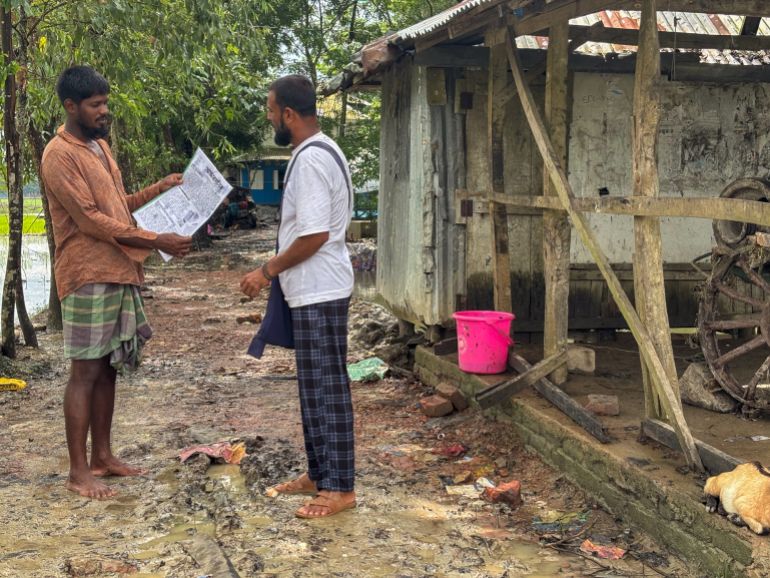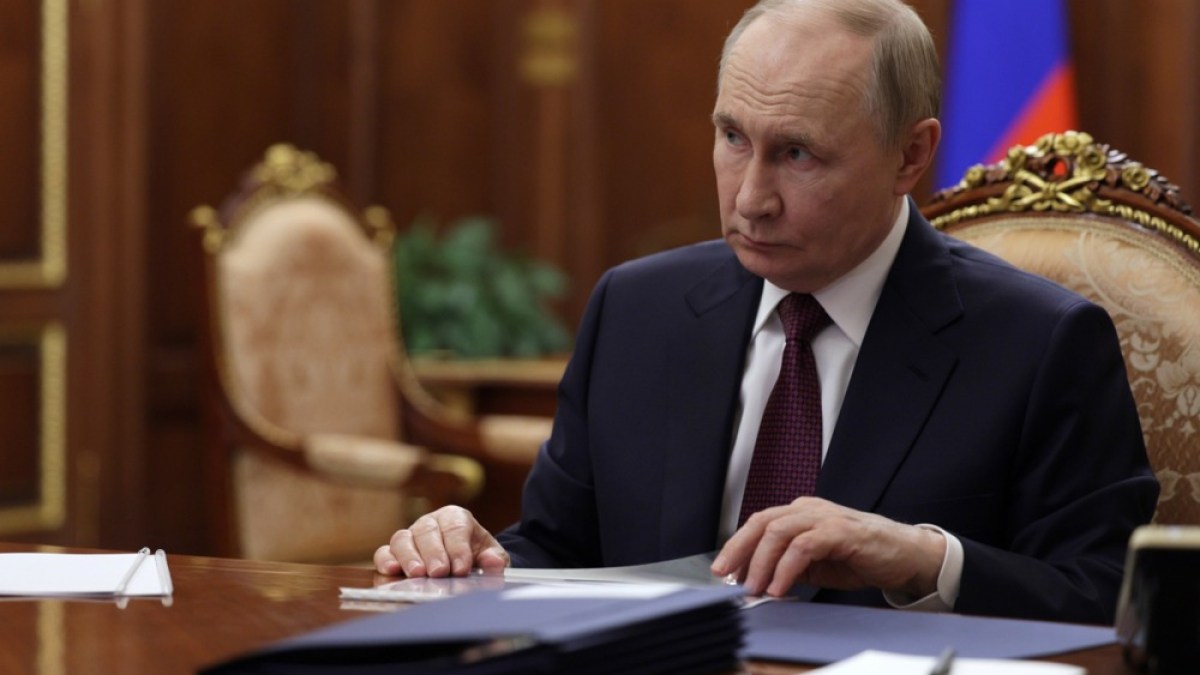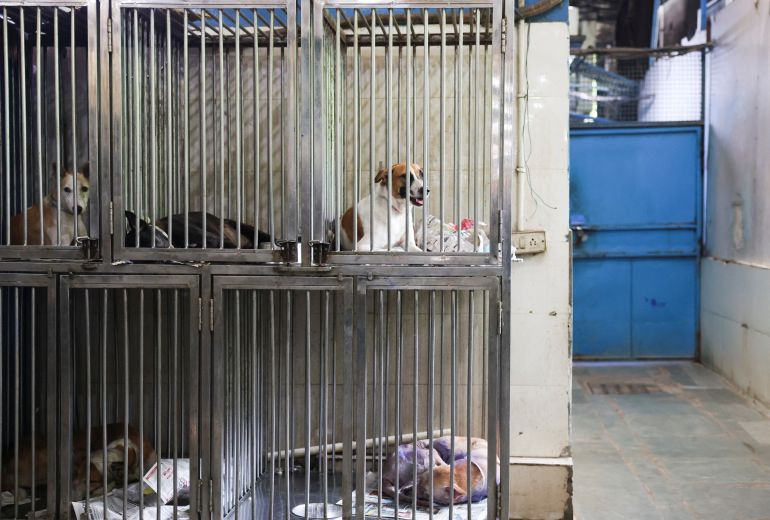West Sonatala, Bangladesh – A busy fish market is the start of Andharmanik, a small community newspaper.
Walking down the steps from the road to the fish landing point in Mohipur, a town in the district of Patuakhali bordering the Bay of Bengal, the smell of salt and fish hangs heavy in the air. Colorful fishing boats with red, blue, and green paint are moored next to the main landing platform.
At this busy market in late July, larger fishing depots and much smaller shanty-style stalls stand side by side. Hasan Parvez, 44, shovels ice into plastic containers piled high with the prized national fish, silvery hilsa, which is transported daily to cities like Dhaka and Barisal at one of the small, metal-roofed stalls. He has black cotton pants rolled up to his knees.
Hasan works surrounded by plastic barrels and crates glistening with the fresh catch of the day, and there is a constant background thrum of diesel-powered trawlers humming as boats pull in and out of the dock.
Hasan smiles and says, “It’s a busy morning, and it’s a fish market with all the chaos.”
He works there as a daily wage labourer sorting, weighing and packing fish into white thermocol boxes during the monsoon season. He works at a nearby brick factory during the dry season, and he works at a market where sun-dried fish called “shutki” is sold during the winter months, in December and January.
Hasan’s day at Mohipur market starts early – around 4am – with the fajr prayer and a cup of tea without milk, and earns him about 600 taka ($5) per day.
He is impatient to finish today, as usual because he has another job to fill in besides the one he needs to support his family. He is the editor-in-chief of a handwritten community newspaper called Andharmanik (“jewel from the darkness” in Bengali, and also the name of the nearby river), which features stories from his village of West Sonatala. He publishes it from his coastal village home every two months, which is less than an hour by road from the fish market and more than eight hours by air.
Since Hasan and his team of reporters don’t own or use computers, the newspaper is handwritten and then photocopied. They also think that writing stories by hand, especially in places like Andharmanik, makes the paper feel more intimate and draws their local communities closer together.
Finally, at around 11am, when the last boxes of fish have been loaded onto carts and the shop floor has been cleaned, Hasan prepares to head home.
To get home, he hops onto a battery-operated, three-wheeled van-gari, which has a large wooden platform at the back of the car where passengers can rest.
As Hasan climbs into the vehicle, he explains that the three-room home he shares with his wife, Salma Begum, whom he married in 2013, and three daughters, is also the editorial headquarters for Andharmanik. He meets with the team once or twice during each publication cycle there.
“My village,”
On the bumpy, broken road to his home, past paddy fields and scattered houses, a few two-wheelers and electric rickshaws passing by in the opposite direction, Hasan explains what drove him to start a newspaper.
He remarks loudly over the obnoxious van-gari engine, “I used to write a lot of poems in my childhood.” “Reading and writing always attracted me”.
Rabindranath Tagore, an Indian poet and author of the Nobel Prize, would give his readings as well as self-help books. But despite his love of reading and learning, he wasn’t able to finish school. Hasan, the eldest of two brothers and two sisters, had to leave school when he was 14 to make ends meet with his family. “I was supposed to pass my secondary school certification (SSC) exam back in 1996, but I couldn’t do it because of money problems”, he explains.
At the age of 35, he didn’t pass his SSC exam in the 10th grade. Two years later, he finished high school. He enrolled in a college in Kalapara, which is about 10 kilometers (6,2 miles) away, in order to pursue a Bachelor of Arts degree in 2021. Having to juggle supporting his family with the newspaper and his studies, he is just now in his second semester. He claims that this has been a significant step in shaping the newspaper’s future.
Hasan wants to register the newspaper in the district as an official media organisation, as he believes this would help protect it from political volatility. The publisher must be a graduate, he says, according to the rules.
The idea for the paper arose in June 2016 when Hasan met Rafiqul Montu, a Dhaka-based environmental journalist who was visiting the area. Montu travels to the area all year to see his work and examine the effects of the climate crisis in Bangladesh’s coastal areas. One day, Hasan saw him taking pictures of the Andharmanik River. He approached him to speak with him, which was bizarre.
As they spoke, Hasan shared some of his poems and other writings. He addressed the issues facing his village in those discussions, such as the cyclones that plague them or the farmers who are suffering from the worst weather. No newspaper covered these stories, and with the local government often slow to help, people felt neglected.
Montu urged him to publish these stories in a newspaper after being impressed by what he heard.
“He wanted to do something for his community”, Montu explains. I gave him permission to write for and cover local news. I said he should focus on spreading good faith and hope in his community”.
He suggested that Hasan be taught how to write a story, write headlines, and take pictures with his mobile phone, and suggested that the paper be named after the river where they sat.
“Montu bhai (brother) is my ustaad (mentor)”, Hasan says. He “inspired me to write about the problems and solutions that exist in the lives of my village and the people I serve.” I had never thought of becoming a newspaper publisher since I can’t afford to be one. But Andharmanik has been out for six years.
As a tribute to the working-class community of West Sonatala, the paper’s first issue was published in 2019 on May 1, Labour Day.

Forgotten by the world
Hasan approaches his village in the untamed countryside around noon as a result of a light drizzle. Green rice fields spread out from both sides of the road, and the trees lining it are wet from the rain.
A few ponds along the side of the road house ducks. The van-gari bounces over the last stretch of broken road until it finally runs out altogether. The driver can only go this far.
From there, it is a 10-minute walk along muddy paths to reach Hasan’s house.
Officially, he claims, “but this is what it looks like,” but the road actually enters my home.
A narrow strip of slushy mud is all there is to walk on, and the monsoon has made conditions worse. Villagers are left to walk barefoot, wearing sandals or shoes.
“Wearing shoes isn’t practical as they can get stuck in the mud and cause someone to slip and fall”, Hasan says as he hurries to meet his team, who will arrive for a 1pm meeting to discuss ideas for the August edition. A team of 17 reporters who voluntarily contribute stories and photos has grown from 10 contributors to the newspaper.
“In our meetings, we share story ideas, but also talk about our own lives and families. My wife frequently serves us with tea and muri (puffed rice), he continues.
West Sonatala is home to 618 families – mostly farmers, fishermen and daily wage labourers. Just a few years ago, electricity was only available.
“There’s one community clinic in the village with no doctors. According to Hasan, those who get sick in the village are transported to hospitals in Kalapara, a small, hour-long drive from the village.
“No national or regional newspapers come to the village, and most homes don’t have a TV. He continues, gesturing at his mobile phone, which shows no network connection, explaining that the internet is so patchy even for those with smartphones.
“Our area is so remote and cut off from basic information that we feel forgotten by the mainstream world”, he says. Andharmanik was born out of a sense of isolation, which inspired me to start it. It’s our community newspaper to tell our own stories”.
![Handwritten newspaper [Diwash Gahatraj/Al Jazeera]](https://i0.wp.com/www.aljazeera.com/wp-content/uploads/2025/08/IMG_2997-1755590096.jpg?w=696&ssl=1)
‘ A collective ‘
A few Bengali bookcases and framed newspaper clippings are on the wall in Hasan’s living room. A long, wooden table sits in the centre where Hasan’s reporters gather, arriving one by one along the muddy paths. Today, three braved the heavy rain to get there. Abdul Latif is the first to arrive, followed by Russiah Begum, then Nazrul Islam Bilal. They say, “Kemon asen,” and they leave the room with smiles on their faces and start asking about each other’s well-being. (“How are you”? in Bengali ;).
The group is small, but diverse, and they all live near each other within a cluster of villages. Abdul, 42, a high school English teacher, wears a crisp, white checkered shirt. Nazrul, 31, is an electrician. One of the three women on the team, Russiah, 43, owns and runs a tailoring business from her home in West Sonatala.
![Handwritten newspaper [Diwash Gahatraj/Al Jazeera]](https://i0.wp.com/www.aljazeera.com/wp-content/uploads/2025/08/IMG_3070-1755590086.jpg?w=696&ssl=1)
Sahana Begum, 55, a polio patient, and her two other core team members, who have been prevented from attending the meeting, are also unable to attend because of the rain. Sahana, who is also a seamstress, lives in West Sonatala and writes about women’s issues. Ashish Garami, the only Hindu member of the team, is also present. He belongs to a minority group in Bangladesh, which in recent years has reportedly faced discrimination.
Some of the contributors are unemployed, while others are farmers and e-rickshaw drivers.
“We work as a collective. According to Abdul, who joined Andharmanik in 2021, our newspaper concentrates on local news, community events, and what takes place in West Sonatala and occasionally nearby villages. “In this edition, I am going to write about the bad road conditions”, he adds. “I’ll show how people are suffering as a result of the monsoon.”
The school where he teaches is three kilometres (1.9 miles) from his home, and he has to cross the Andharmanik River by boat each day to reach it.
Andharmanik was published because of crusis. The way Hasan pointed out the problems of our village through his writings inspired me to join the team”, he says.
![Handwritten newspaper [Diwash Gahatraj/Al Jazeera]](https://i0.wp.com/www.aljazeera.com/wp-content/uploads/2025/08/IMG_3104-1755590058.jpg?w=696&ssl=1)
‘ Something beautiful happened ‘
Hasan’s team has had Russian involvement since its beginning. She explains that she finished 10th grade before marrying a farmer from the village. She started a tailoring business to provide for her family, opening a window into the secret struggles of the village. “When women come to me to stitch their clothes, they open their hearts”, she says. I’ve heard stories of problems that never leave the outside world, particularly the suffering that children and women endure silently.
One of her stories was about a woman named Abejaan Begum from Rehmatpur village, a few kilometres from West Sonatala. In 2023, Abejaan had been forced to flee to a makeshift hut made of plastic sheets after losing her home to devastating floods.
“My story was shared by Hasan on his Facebook page”, Begum says. “Then something lovely happened: Bangladeshis living abroad began receiving assistance. In total, she received 60, 000 taka ($420) to build a new house and buy a few goats”. According to Russiah, Abejaan is now living in a three-room home with dignity once more.
Their stories have helped others. In a poem about a child named Rubina from Hasan’s village who was kept in chains and lived in a broken mud hut with her grandmother and mother, who had mental health issues. Because they were so poor, Rubina was forced to beg for food. The poem was widely read and attracted the attention of local government officials, who decided to grant Rubina and her family some land and a home after Hasan’s publication.
Hasan and his team often focus on stories about how people are affected by the climate crisis. Flooding, heatwaves, rising sea levels, rising sea levels, and saltwater intrusion are all common in Bangladesh’s coastal areas. Bilal owns a small rice field, and he feels connected to other farmers in the area, particularly as he sees his harvest get smaller every year due to the erratic rainfall.
He claims that “in the next issue, I’ll write about the struggles of local day laborers during the monsoon.”
Hasan’s reporters submit their stories on sheets from notebooks. “I receive the handwritten notes from our contributors.” I make the final decision on what goes in the paper and edit the language”, he says. He then photocopies the stories at a Kalapara copy shop using a fountain pen and A3-size paper.
Each newspaper is four pages long and bound together using colourful plastic tape. Hasan produces 300 copies, each costing him about 10 taka ($0.08) to publish. The process is labour-intensive and the final handwriting, printing and binding takes about a week.
Hasan and his team deliver the paper to West Sonatala and the nearby Tungibari, Chandpara, Rehmatpur, and Fatehpur once it has been published. They have no newspaper stall or subscription system, relying solely on local demand. They either give it away for nothing or, where possible, sell it for a fee. “People are poor in our village, so it’s mostly given free. I really don’t get paid for it, to be honest. This is not my goal”, Hasan says.

A loyal reader
One of the newspaper’s most devoted readers and Hasan’s neighbor is Azizur Rehman Khan, 84, a resident of West Sonatala. He has read every issue for the past two years and happily pays for each issue, which is delivered to him personally by Hasan.
According to Azizur, “I have seen Parvez since he was a child.” “I love his passion and motivation to tell stories of happiness and sadness of our villagers. Andharmanik is the one who tells the world our story when the rest of the world forgets us.
The former tax officer says he understands the financial insecurity that Hasan shoulders in order to publish the newspaper. He continues, “I pray to Allah that a day will come when everything will work together and that this paper will be published fortnightly.”
Khan lives a couple of kilometres from the Andharmanik River. He explains the origin of the name, which is derived from two Bengali words, “andhar” meaning dark and “manik” meaning jewel.








